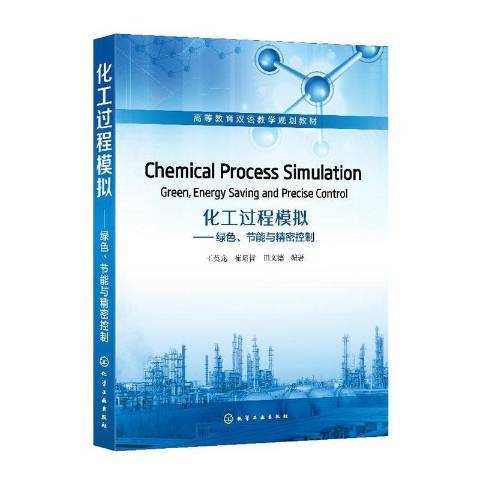《化工過程模擬:綠色、節能與精密控制》是2019年化學工業出版社出版的圖書。
基本介紹
- 中文名:化工過程模擬:綠色、節能與精密控制
- 作者:王英龍
- 出版社:化學工業出版社
- 出版時間:2019年
- 開本:16 開
- 裝幀:平裝
- ISBN:9787122357243
內容簡介,圖書目錄,
內容簡介
《Chemical Process Simulation》將研究生學術思維訓練與過程模擬實踐相結合,旨在提高研究生的科學認知與工程實踐能力。本書利用GROMACS, Materials Studio, Aspen Plus, MATLAB等軟體,從分子動力學、相平衡、穩態模擬及動態控制等方面,重點闡述化工過程模擬的綠色、節能與精密控制技術。本書共11章內容,第1章主要介紹汽液平衡和液液平衡實驗數據的回歸,第2章主要介紹離子液體相行為及其熱力學性質的預測,離子液體在分離混合物方面的套用,第3~5章主要介紹過程強化與集成方面的實例,主要包括膜分離、熱集成、熱耦合、熱泵隔壁塔精餾技術,第6~11章主要介紹了萃取精餾、變壓精餾、間歇精餾及反應精餾等精餾過程的動態控制案例。
《Chemical Process Simulation》可作為高等院校化工等相關專業研究生的教學參考書,也可供從事化工過程開發與設計的工程技術人員參考。
圖書目錄
Chapter 1 Simulation of Vapor-liquid and Liquid-liquid Equilibrium for Binary/ Ternary Systems
1.1 Introduction / 1
1.2 Data Regression of Binary System / 1
1.3 Data Regression of Ternary System by NRTL / 8
1.4 Data Regression of Ternary System by UNIQUAC / 11
References / 13
Chapter 2 Application of Green Solvents in Absorption and Extraction
2.1 Introduction / 14
2.2 Molecular Dynamics Simulation / 14
2.2.1 Generating GROMACS Supported Files / 15
2.2.2 Defining the Unit Box and Filling Solvent / 20
2.2.3 Energy Minimization / 22
2.2.4 NVT Balance / 24
2.2.5 NPT Balance / 26
2.2.6 Finishing MD / 27
2.2.7 Analysis / 28
2.3 Simulation of Extractive Distillation Using the Ionic Liquid / 30
2.3.1 Analysis of Correlation Model / 30
2.3.2 Definition of the Ionic Liquid in Aspen Plus / 32
2.4 Simulation of CO2 Absorption Using the Ionic Liquid / 37
2.4.1 Calculation of σ-profile Value / 38
2.4.2 Definition of the Ionic Liquid in Aspen Plus / 43
2.4.3 Simulation of CO2 Capture Using the Ionic Liquid / 44
2.5 Simulation of Extractive Distillation Using Deep Eutectic Solvents / 49
2.5.1 Definition of Deep Eutectic Solvents in Aspen Plus / 50
2.5.2 Process Simulation / 52
References / 54
Chapter 3 Membrane Separation Process
3.1 Introduction / 56
3.2 Principle of Membrane Separation / 56
3.3 Separation of DMSO-water Using Membrane / 57
References / 64
Chapter 4 Heat-integration and Thermally Coupled Distillation
4.1 Introduction / 65
4.2 Steady-state Simulation of THF-methanol System with Heat- integration / 66
4.2.1 Simulation without Heat-integration / 66
4.2.2 Simulation with Partial Heat-integration / 70
4.2.3 Simulation with Full Heat-integration / 73
4.3 Thermally Coupled Distillation Process / 76
4.4 Energy-saving Thermally Coupled Ternary Extractive Distillation Process / 78
References / 86
Chapter 5 Heat Pump Distillation for Close-boiling Mixture
5.1 Introduction / 88
5.2 Main Forms of Heat Pump Distillation / 88
5.3 Heat Pump Distillation Process of Binary System Close-boiling Mixture / 90
References / 99
Chapter 6 Energy-saving Side-stream Extractive Distillation Process
6.1 Introduction / 100
6.2 Steady-state Design of Side-stream Extractive Distillation / 100
6.3 Dynamic Control of Side-stream Extractive Distillation / 101
6.3.1 Control Structure with Side-stream Composition/Temperature Cascade Connection / 105
6.3.2 Control Structure with S/F and Composition Controller Connection / 105
6.3.3 Improved Dynamic Control Structure / 107
References / 112
Chapter 7 Pressure-swing Distillation for Minimum-boiling Azeotropes
7.1 Introduction / 113
7.2 Converting from Steady-state to Dynamic Simulation / 113
7.3 Control Structures of the Process without Heat-integration / 116
7.3.1 Basic Control Structure / 116
7.3.2 QR/F1 Control Structure / 127
7.3.3 Control Structures of the Process with FullHeat-integration / 128
References / 130
Chapter 8 Ternary Extractive Distillation System Using Mixed Entrainer
8.1 Introduction / 132
8.2 Converting from Steady-state to Dynamic Simulation / 132
8.3 Dynamic Control of Ternary Extractive Distillation Process Using Single Solvent / 135
8.3.1 Basic Control Structure / 135
8.3.2 Dual Temperature Control Structure / 140
8.3.3 Composition with Q R/F Control Structure / 142
8.4 Dynamic Control of Ternary Extractive Distillation Process Using Mixed Entrainer / 145
8.4.1 Basic Control Structure / 145
8.4.2 Composition with Q R/F Control Structure / 146
8.5 Comparisons of the Dynamic Performances of Two Processes / 148
References / 152
Chapter 9 Hybrid Process Including Extraction and Distillation
9.1 Introduction / 153
9.2 Solvent Selection / 153
9.3 Simulation of the Extraction Combined with Distillation Process / 155
9.3.1 Extraction Combined with Heterogeneous Azeotropic Distillation Process (LEHAD) / 155
9.3.2 Extraction Combined with Extractive Distillation Process (LEED) / 160
9.4 Dynamic Simulation of Hybrid Extraction-distillation / 164
9.4.1 Selection of Temperature-sensitive Trays / 164
9.4.2 Dynamic Control of the LEHAD Process / 167
9.4.3 Dynamic Control of the LEED Process / 174
9.5 Energy-saving Hybrid Process with Mixed Solvent / 181
9.6 Dynamics of Hybrid Process with Mixed Solvent / 185
9.6.1 Selection of Temperature-sensitive Trays / 185
9.6.2 Control Structure with Fixed Reflux Ratio / 187
References / 190
Chapter 10 Batch Distillation Integrated with Quasi-continuous Process
10.1 Introduction / 191
10.2 Feasibility of Pressure-swing Batch Distillation Based on the Ternary Residue Curve Maps / 191
10.3 Double Column Batch Stripper Process / 193
10.3.1 Design of Double Column Batch Stripper Process / 193
10.3.2 Control of Double Column Batch Stripper Process / 196
10.4 Triple Column Process / 201
10.4.1 Design of Triple Column Process / 201
10.4.2 Control of Triple Column Process / 202
References / 206
Chapter 11 Simulation of Chemical Reaction Process Based on Reaction Kinetics
11.1 Introduction / 207
11.2 Continuously Stirred Tank Reactor / 208
11.3 Simulation of Cyclohexanone Ammoximation Process / 209
11.3.1 Steady-state Simulation of Cyclohexanone Ammoximation Process / 209
11.3.2 Dynamic Simulation of Cyclohexanone Ammoximation Process / 209
References / 225

